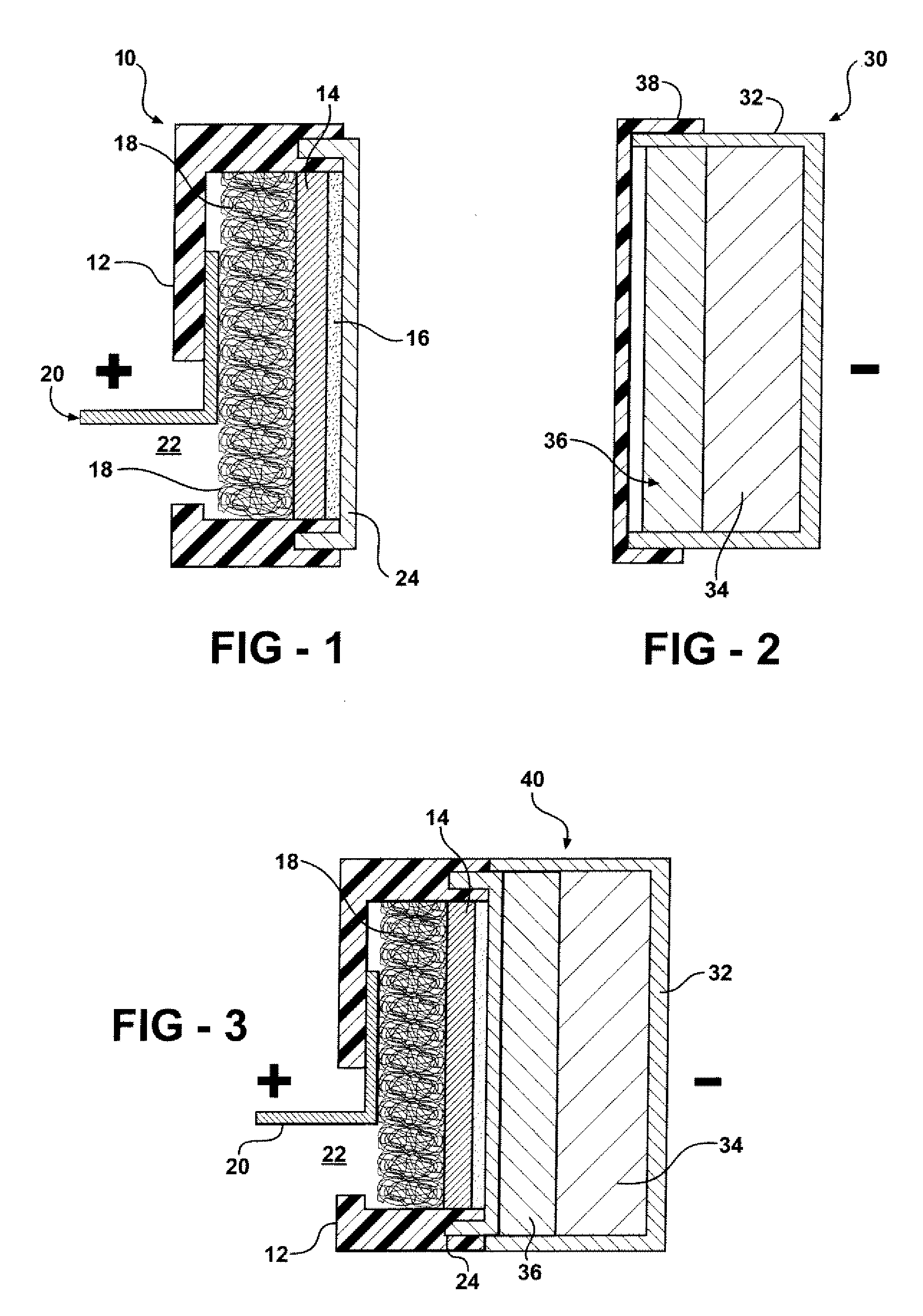Molybdenum/air battery and cell design
a technology of air batteries and molybdenum/air batteries, applied in the field of electrochemical cells, can solve the problems of high theoretical voltage of zinc-air batteries, limited ultimate energy density, and unstable batteries utilizing magnesium or aluminum-based anodes, and achieve the effect of reducing oxygen
- Summary
- Abstract
- Description
- Claims
- Application Information
AI Technical Summary
Benefits of technology
Problems solved by technology
Method used
Image
Examples
example 1
[0044]The Mo-air battery's performance will depend on the type of electrolyte utilized. FIG. 4 shows the voltage-current curve of a Mo-air battery using alkaline and acidic electrolytes. In the alkaline electrolyte the open circuit voltage is 1.0 V, only about 0.3 V lower than the theoretical cell voltage of 1.31 V. In acidic electrolyte the open circuit voltage is 0.55 V, about only half of the theoretical cell voltage of 1.12 V. The high over potential of the Mo-air battery in acidic electrolyte is brought about by the accumulation of metal oxide layers on the Mo metal particle surface. The alkaline electrolyte is good for dissolving the surface layer of metal oxides, so the over potential of the battery decreases significantly. As shown in FIG. 4, at a given voltage the discharge current for the cell using alkaline electrolyte is remarkably higher than that for the cell using acidic electrolyte. FIG. 5 shows discharge power-current curves of the Mo-air cell using alkaline and aci...
example 2
[0045]The open circuit voltage of the Mo-air battery shifts up with increasing concentration of the alkaline electrolyte. FIG. 6 shows the effect of KOH concentration on the discharge performance of the Mo-air battery. When KOH concentration is increased from 30% to 60% the open circuit voltage increases from 1.0 V to 1.2 V. However, a high concentration of KOH is detrimental to cell operation at high current discharge. At 0.2 V the discharge current reaches 30 mA / cm2 when 30% KOH is used as electrolyte, but only 17 mA / cm2 when 60% KOH is used as electrolyte. FIG. 7 shows the power-current curves of the Mo-air cell using 30% and 60% KOH as electrolyte respectively. The discharge peak power is roughly equal (8 mW / cm2) even if using different concentrations of KOH. However, the peak power is obtained at different discharge currents. The location of peak power is at a current of 25 mA / cm2 when using 30% KOH as the electrolyte and at current of 11 mA / cm2 when using 60% KOH as the electr...
example 3
[0046]Constant current discharge is used to examine the long-term performance of the Mo-air battery. FIG. 8 shows the discharge performance at a constant current of 1 mA / cm2 and 5 mA / cm2 while using 30% KOH as electrolyte. The voltage-time curves are relatively flat for 8 hours discharge. There is a small decrease in voltage over time, and this is believed to be the result of an accumulation of metal oxide on the metal particle surface, which operates to block the electrical conductivity and increase the cell's resistance. Based on the long-term discharge experiments like those of FIG. 8, the energy density, power density and the electrochemical parameters were calculated for the Mo-air cell. Table 1 summarizes the electrochemical performance of the Mo-air battery.
TABLE 1Electrochemical parameters of the Mo-air cellMo-air batteryCapacity based on Mo + 2 KOH (Ah / Kg)773Theoretical voltage (V)1.31Experimental open circuit voltage (V)*1.0*Theoretical energy based on Mo + 2 KOH (Wh / Kg)10...
PUM
| Property | Measurement | Unit |
|---|---|---|
| electrical power | aaaaa | aaaaa |
| reduction | aaaaa | aaaaa |
| air permeable | aaaaa | aaaaa |
Abstract
Description
Claims
Application Information
 Login to View More
Login to View More - R&D
- Intellectual Property
- Life Sciences
- Materials
- Tech Scout
- Unparalleled Data Quality
- Higher Quality Content
- 60% Fewer Hallucinations
Browse by: Latest US Patents, China's latest patents, Technical Efficacy Thesaurus, Application Domain, Technology Topic, Popular Technical Reports.
© 2025 PatSnap. All rights reserved.Legal|Privacy policy|Modern Slavery Act Transparency Statement|Sitemap|About US| Contact US: help@patsnap.com



